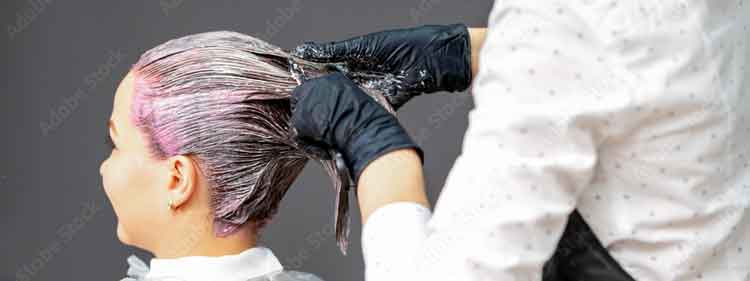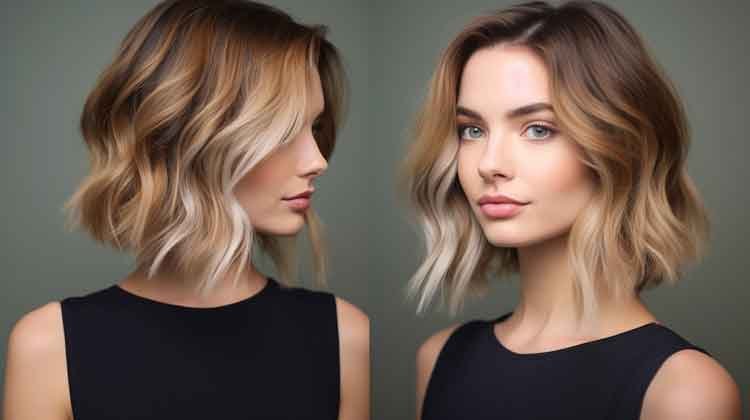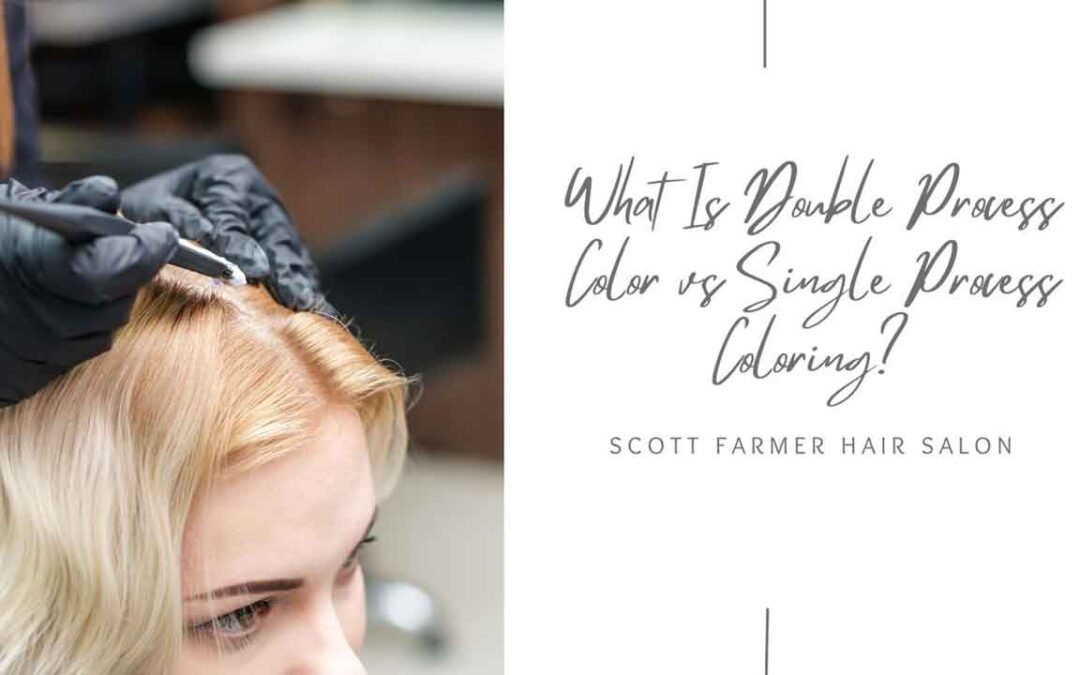What Is Double Process Color?
You may wonder, What Is Double Process Color and the Process?
Double process color is a hair coloring technique involving two steps to achieve the final color. Here’s how it works:
- Lightening/Bleaching: The first step involves lightening or bleaching the hair to remove its natural color. This step prepares the hair for the new color and is crucial for achieving dramatic color changes, such as going from dark brunette to platinum blonde.
- Toning/Coloring: In the second step, a toner or the desired color is applied to the pre-lightened hair. This step ensures the final color is precisely what you want, whether a natural shade or a vibrant pastel.
Double-process color allows precise control over the final shade and is ideal for significant color transformations. It’s perfect for achieving light or vibrant colors that single-process coloring can’t provide.
However, double-process color is more complex and time-consuming, requiring additional maintenance to keep it looking its best. Consulting with a professional colorist is essential to determine if this technique suits your hair type and color goals.
When you’re ready for a hair transformation, understanding the difference between double-process color and single-process coloring can help you achieve your desired look.
Both methods offer distinct benefits and are suited to different hair goals.

Definition of Double Process Color and Single Process Coloring
Double Process Color involves two steps. First, the hair is bleached or lightened to remove the natural coloring. Then, a new color or toner is applied to achieve the desired shade.
This method is perfect for dramatic changes, like going from dark brown to platinum blonde or achieving vivid, pastel hues with the help of a stylist.
Single-process color is a straightforward method in which a single color is applied to the hair in one step; this is often compared in the single process vs balayage debate.
It’s ideal for root touch-ups, covering gray hair, or enhancing natural hair color, which can be enhanced or changed entirely using permanent color.
This process is faster and simpler, providing a uniform color from roots to ends.

Benefits of Double Process Color vs Single Process Coloring
Double Process Color:
- Allows for significant color changes
- Achieves vibrant, precise colors
- Suitable for lightening dark hair to very light shades
- Quick and easy application
- Great for maintaining or enhancing natural hair color
- It is ideal for covering grays or achieving a uniform look with an all-over color.
Which Process Is Suitable for Blonde Hair?
The double process is often necessary for those aiming for blonde hair, especially if starting with dark hair.
This method ensures the hair is lightened adequately before applying the blonde shade, resulting in a brighter, more consistent color.

How Does Double Process Hair Color Differ from Single Process Hair Color?
Double Process Hair Color:
- Bleaching/Lightening: The first step removes the natural color.
- Toning/Coloring: The second step applies the desired shade, natural blonde, or a bold, vibrant color.
- Color Application: A single color is applied directly to the hair, covering the entire head in one step.
Differences in the Application Process
Double Process:
- Time-consuming: Two separate steps.
- Precise color control: Achieves specific, vivid results.
Single Process:
- Faster: One-step process with single process vs other multi-step techniques.
- Uniform color: Ideal for covering grays or adding shine through all-over color techniques.
When to Choose Double Process Color Over Single Process Color at a Salon?
Choose Double Process Color if:
- You want a drastic color change.
- You aim for very light or pastel shades.
- Your natural hair color is dark, and you want to go significantly lighter, which may require an all-over color.
Choose Single Process Color if:
- You need root touch-ups when you color your hair with permanent color.
- You want to enhance your natural hair color.
- You aim for a quick and straightforward color refresh.

Factors Influencing the Choice Between Double and Single Processes
- Desired Color: A double process is best for bold, light shades.
- Starting Color: Darker hair may require a double process for lighter results.
- Time and Cost: Double process takes longer and is typically more expensive.
Difference in Costs Between Double and Single Process Color Services
Double-process services are generally more expensive due to the two-step process and the time involved.
Single-process services are more affordable and quicker compared to balayage.
Which Suits Better for a Complete Hair Color Change?
Double-processing color is the way to overhaul hair color, especially for lighter or more vibrant shades.
It provides the necessary foundation for a dramatic transformation.

Common Misconceptions About Double Process and Single Process Coloring
Myth: Double process is damaging.
Truth: It’s safe and can maintain hair health when done professionally.
Myth: A single process can’t achieve bold colors.
Truth: It can, but it is best for subtle changes or maintenance.
Clarifications on Base Color and Highlights in Both Processes
In double-process coloring, base color refers to the initial lightening step. Highlights can be added in the second step for dimension.
In a single process, highlights are not typically involved unless done separately.
Consult a professional colorist at Scott Farmer Hair Salon for more personalized advice and to explore the best option for your hair goals.
Our experts can guide you through the process and help you achieve the perfect look.
What is the difference between single-process and double-process hair coloring?
Single-process hair coloring involves applying one color to your hair, whereas double-process color requires two separate steps: lightening the hair first and then applying the desired tone.
How does single process color differ from double process color?
Single-process color is ideal for those looking to darken or maintain their current color, while double-process color is used to lighten the hair or achieve a completely new shade.
What are the benefits of single-process coloring over double-process coloring?
Single-process coloring is typically less damaging to the hair as it involves just one treatment, compared to the two-step double-process coloring process.
Can single-process color be used on color-treated or damaged hair?
Yes, single-process color is often a safer option for color-treated or damaged hair, as it is less harsh and can help improve the condition of the hair.
How does double-process color provide extra color compared to single-process color?
Double-process color adds dimension and extra color through the second treatment, making it ideal for vibrant hues or drastic color changes, like Princess Elsa or Gwen Stefani-inspired looks.
When should I choose single process color over double process color?
Opt for single-process color if you want to darken or maintain your current color, have color-treated or damaged hair, or prefer a more subtle change. Double-process color is best for lightening your hair or achieving a bold new shade.
How do highlights differ from double process color?
Highlights involve lightening specific sections of hair to create dimension, while double-process color lightens all over to change the entire hair color. Highlights can be incorporated into both single-process and double-process coloring techniques.
HOW TO CONNECT WITH SCOTT FARMER SALON ONLINE?
FOLLOW ON SOCIAL MEDIA
Please stay connected with us! Follow Scott Farmer Salon on Facebook and Instagram to see our latest work, get hair care tips, and stay updated on special offers and events.

CONTACT US
We would love to get to know you or answer any questions you may have. Please don’t hesitate to contact us.
Scott Farmer Hair Salon in Venice, FL: Expert haircuts, vibrant color, and personalized care for stunning transformations.

